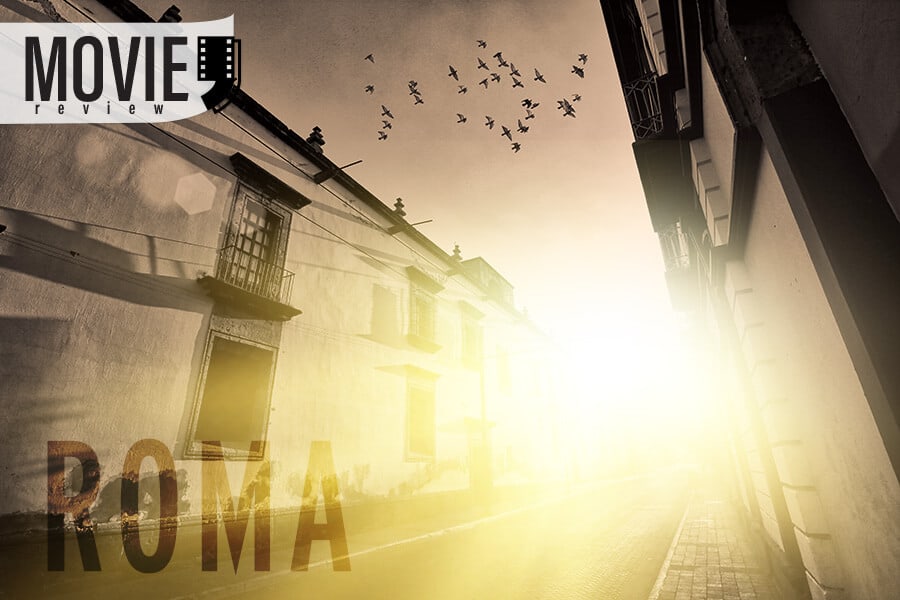The film “Roma” won Oscars in cinematography and direction, with most of the plot consisting of childhood memories of director Alfonso Cuarón. Previously, Cuarón has directed a movie about cosmic space (“Gravity”) and the road movie “Your Mama, too”. Everyone knew a lot about him as a successful director but understood little about his background. But Roma is from a strictly different perspective, with a plot about the fate of a tender woman in a raucous world, filmed in black and white without unnecessary distractions and with compelling cinematography, a unique aesthetic, and clarity of dialogue. The film reflects not only the memories but also the feelings of Alfonso Cuarón, which makes this one of his most subtle works.
Let me clarify right away that Roma is not Rome, but the name of a quarter in Mexico City, and the setting of Alfonso Cuarón’s 2018 drama about Mexico in the ‘70s. In 1971, large-scale political strikes and coup attempts took place in Mexico. Students were murdered, and the most routine venture into the streets could turn into the last one. Against a backdrop of dramatic events, we witness the story of the family of Antonio Fernando Grediaga and Sophie Marina de Tavira, their children, and two housekeepers, among whom is Cleo Yalitza Aparicio, the main character and the prototype of the woman who took care of the house where Cuarón’s childhood took place.
Once, after Antonio goes on a business trip, it becomes clear that he is not going to return either to his wife or to the children. The chaotic but warm life of the family goes on, seemingly as usual, but Cleo notices the despair of the mistress of the house. In parallel with these events, Cleo has cause for concern about her future. She enters into a relationship with a man and soon finds that she is pregnant. Cleo tells the father-to-be that she is expecting a baby, but he rejects parental responsibility.

Student protests against the government did take place in Mexico City in 1971, and some of the protesters were brutally killed. Cuarón considers it necessary to show these events as a backdrop to the story of his childhood. Cleo is an example of how people move at their own pace unless the events in the background become dauntingly dangerous.
For Alfonso Cuarón, the plot is a collective image of shoes clattering, birds chirping, dogs barking, water being poured, and music playing on the radio. As soon as you immerse yourself in this atmosphere, the story itself gradually emerges – events come along, and the feelings of the silent Cleo become clear. During the first hour, there are not many plot twists, but further actions and experiences resonate with those who stay to watch “Roma”.

It was so important for Alfonso Cuaron to show the picture through his own eyes that he even performed the camera work himself. Plenty of scenes were shot only once. Likewise, one of these episodes was the emotional moment with the birth in the hospital, with the doctors and nurses played by real medical professionals, adding a natural atmosphere to the film. And the lead protagonist, the character of Cleo, is played by Yalitsa Aparicio, who had never acted before. That is why Aparicio manages to be so real and touching in her distinctive way, awakening sympathy for her character. Cleo has quite a few lines, but her thoughts and feelings remain unspoken, although this is not an obstacle to understanding what she is thinking about or with what she struggles. Found almost by accident through an exhausting casting process, Yalitsa Aparicio came from a small Mexican village and had visited Mexico City only twice in her life, and presented herself at the casting session the second of time she was ever in the city.

Cleo, or rather Yalitsa Aparicio, looks entirely balanced. She does household chores as her mistress expects, and in the next instant rushes to save children who do not know how to swim in the ocean, or quickly picks them up from under a hail storm and, by example, boldly opens them up to life’s ups and downs.
The film does not give the impression that the emphasis is on social themes such as inequality, discrimination, or human exploitation. Rather the opposite. Cleo is accepted into the family as a welcome member. They help her when necessary and support her in difficult times. Likewise, she is ready to give her last to be a true friend for them.
Roma leaves a warm after-taste, similar to what we experience when thinking about our own relatives. Most likely, it was Cuaron’s goal to convey feelings of gratitude and respect towards most of the characters from his childhood. He was also born into a substantial family, with two more children. His father was a doctor who spent most of his time at work. The realities of loneliness and solitude are reflected not only in Cleo’s actions and silence but also in the viewer’s constant presence. As if in a cocoon of isolation, it is both compatible and impossible at the same time. This is why the film “Roma” is called a semi-biopic, because the director shows not only the housekeeper’s feelings but also his own concerning the events of that time.
The film belongs to Netflix, although it was first seen at the Cannes Film Festival. The decision to show it at Cannes was not easily arrived at. “Roma” surpassed all the critics’ expectations and became a film to re-visit again and again, and a reason to look at Alfonso Cuarón’s talent in a new way.
Photos: Shutterstock / Photomontage: Martina Advaney
More reviews from the author:
Directed by Christopher Nolan: Besties of the Multi-Genre Genius
Support us!
All your donations will be used to pay the magazine’s journalists and to support the ongoing costs of maintaining the site.
Share this post
Interested in co-operating with us?
We are open to co-operation from writers and businesses alike. You can reach us on our email at cooperations@youthtimemag.com/magazine@youthtimemag.com and we will get back to you as quick as we can.









